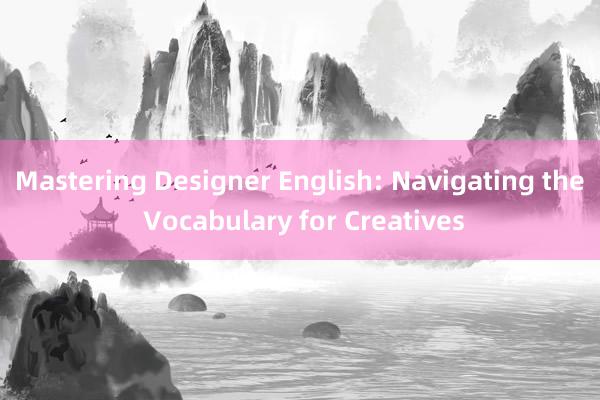时间:2024-10-11 08:04

### Mastering Designer English: Navigating the Vocabulary for Creatives
In the world of design, effective communication is as essential as creativity itself. Designers often find themselves navigating through a unique language, known colloquially as "Designer English." This specialized vocabulary isn't just about jargon; it's a rich tapestry woven with terms that encapsulate the nuances of design thinking, methodologies, and aesthetics. Understanding this language can significantly enhance collaboration, facilitate innovation, and improve the overall quality of design projects. Here’s how to master Designer English:
#### 1. **Design Terminology**: Begin by familiarizing yourself with basic design terms such as "prototype," "wireframe," "mockup," and "layout." These terms are foundational and are used across various design disciplines. For instance, "prototype" refers to an early version of a product designed to test ideas or functionality, while "layout" encompasses the arrangement of elements on a page or screen.
#### 2. **Understanding Design Methodologies**: Delve into design methodologies like Agile, Lean UX, and Design Thinking. Each has its own set of vocabulary and principles. For example, "iteration" in Agile design refers to the process of refining a product through successive versions, whereas "Empathy" is a crucial component of Design Thinking, emphasizing the importance of understanding user needs and experiences.
#### 3. **Graphic Design Specifics**: Terms like "color theory," "typography," and "composition" are pivotal in graphic design. Color theory involves the study of colors and their effects, while typography focuses on the art of arranging type to make written language legible,大石桥市毛绢纺织厂 readable, and appealing when displayed. Composition deals with the arrangement of visual elements in a way that creates a harmonious and effective design.
#### 4. **Web Design Jargon**: In web design, understanding terms such as "responsive design," "mobile-first," and "web accessibility" is crucial. Responsive design ensures that websites adapt to different screen sizes, enhancing user experience across devices. "Mobile-first" design approach prioritizes the development of interfaces for mobile devices first, followed by desktop versions. Web accessibility involves designing websites so they can be used by people with disabilities, ensuring inclusivity.
#### 5. **Project Management Vocabulary**: Design projects often require a blend of creative and strategic skills. Familiarize yourself with project management terms such as "Gantt chart," "milestones," and "KPIs" (Key Performance Indicators). These tools help in planning, executing, and measuring the success of design projects effectively.
#### 6. **Networking and Collaboration**: Engage with the design community through workshops, conferences, and online forums. Learning from experienced designers and participating in discussions can provide insights into industry-specific lingo and best practices.
#### 7. **Continuous Learning**: The field of design is constantly evolving. Stay updated with the latest trends, technologies, and terminologies by reading design blogs, following industry leaders on social media, and attending webinars and courses.
中山市交通项目建设有限公司By mastering the vocabulary of Designer English大石桥市毛绢纺织厂, you not only enhance your professional communication but also deepen your understanding of design processes and principles. This linguistic proficiency can significantly contribute to your career growth and effectiveness in collaborative environments.